Public Health Report: Type 2 Diabetes Challenges in the UK
VerifiedAdded on 2023/01/17
|10
|3616
|58
Report
AI Summary
This report delves into the multifaceted challenges of Type 2 Diabetes within the context of public health in the United Kingdom. It begins by analyzing local health data, focusing on the London Borough and Harrow, highlighting the prevalence of the disease and the factors contributing to its spread, such as lifestyle and demographics. The report then expands to examine national health data, revealing the widespread impact of Type 2 Diabetes across the UK population, including the high percentage of undiagnosed cases and the resulting implications for healthcare. It evaluates the effectiveness of public health strategies, emphasizing the roles of public health institutions in education, prevention, and providing healthcare services. Furthermore, the report details various interventions, including lifestyle modifications, and healthcare initiatives aimed at reducing the incidence and impact of Type 2 Diabetes. Finally, it critically assesses the roles and responsibilities of nurses in promoting health and protecting adults at risk, emphasizing their crucial role in patient care, education, and long-term management of the disease, while acknowledging the challenges associated with patient compliance and engagement.

Public health
Paraphrase This Document
Need a fresh take? Get an instant paraphrase of this document with our AI Paraphraser
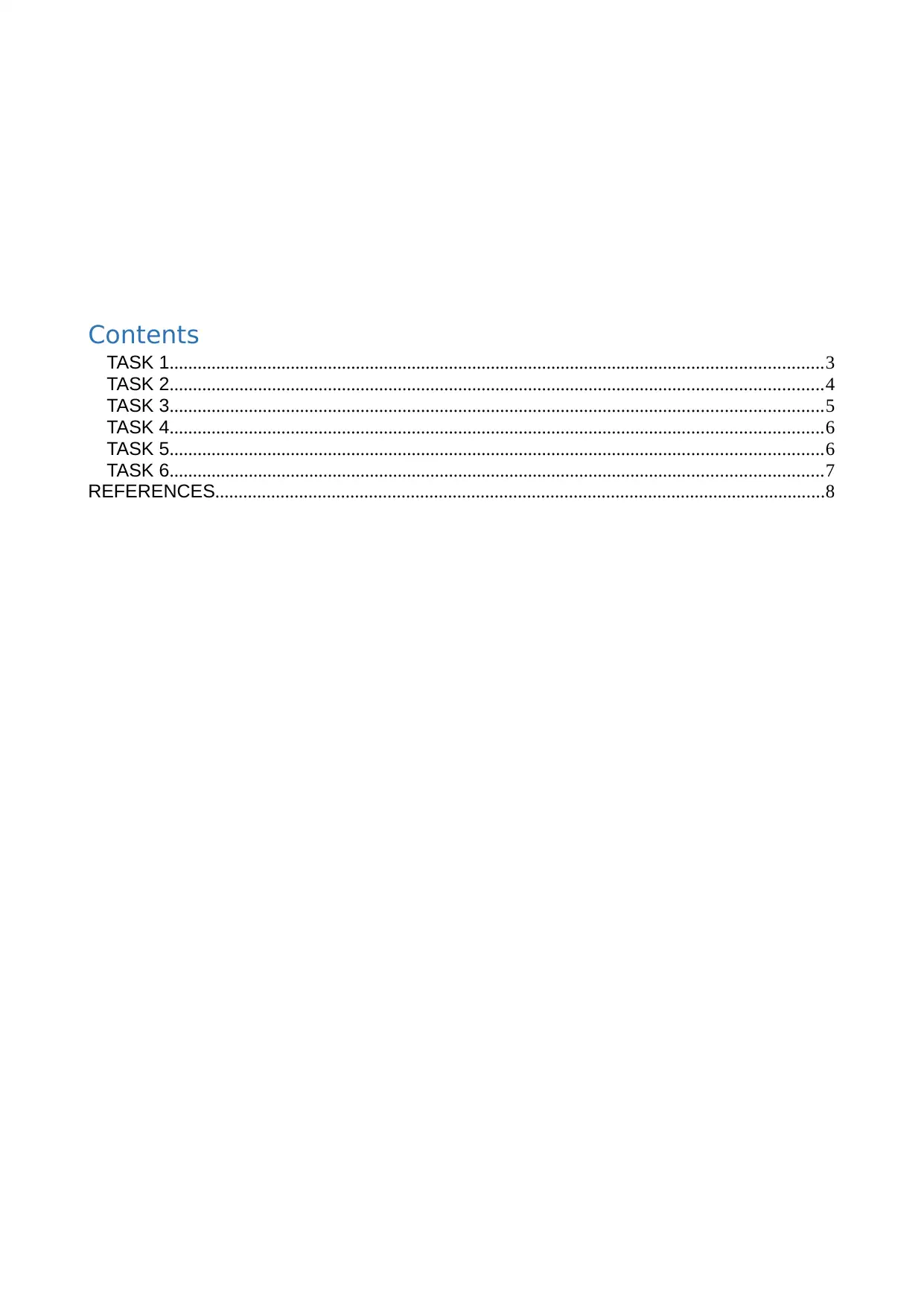
Contents
TASK 1............................................................................................................................................3
TASK 2............................................................................................................................................4
TASK 3............................................................................................................................................5
TASK 4............................................................................................................................................6
TASK 5............................................................................................................................................6
TASK 6............................................................................................................................................7
REFERENCES...................................................................................................................................8
TASK 1............................................................................................................................................3
TASK 2............................................................................................................................................4
TASK 3............................................................................................................................................5
TASK 4............................................................................................................................................6
TASK 5............................................................................................................................................6
TASK 6............................................................................................................................................7
REFERENCES...................................................................................................................................8
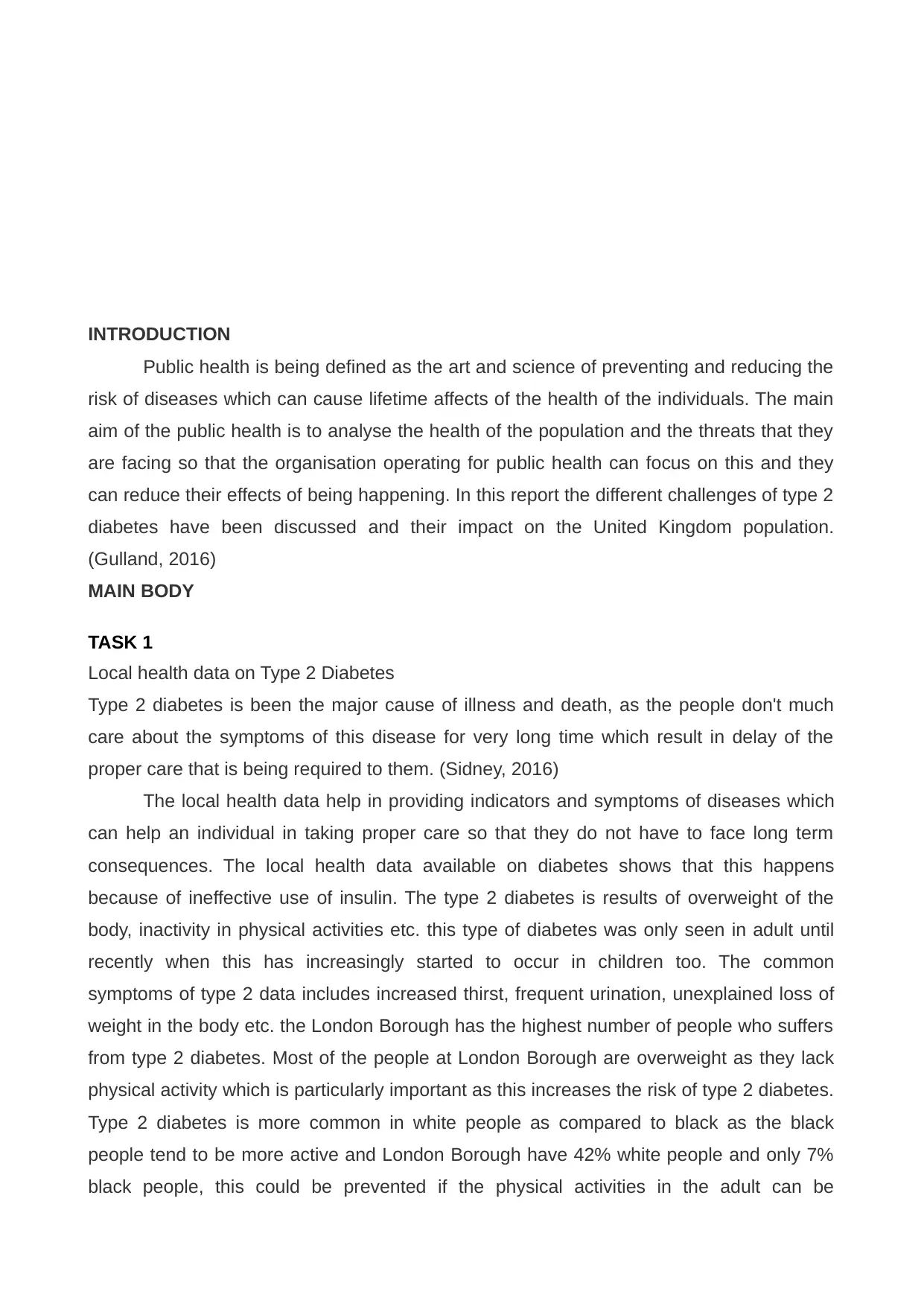
INTRODUCTION
Public health is being defined as the art and science of preventing and reducing the
risk of diseases which can cause lifetime affects of the health of the individuals. The main
aim of the public health is to analyse the health of the population and the threats that they
are facing so that the organisation operating for public health can focus on this and they
can reduce their effects of being happening. In this report the different challenges of type 2
diabetes have been discussed and their impact on the United Kingdom population.
(Gulland, 2016)
MAIN BODY
TASK 1
Local health data on Type 2 Diabetes
Type 2 diabetes is been the major cause of illness and death, as the people don't much
care about the symptoms of this disease for very long time which result in delay of the
proper care that is being required to them. (Sidney, 2016)
The local health data help in providing indicators and symptoms of diseases which
can help an individual in taking proper care so that they do not have to face long term
consequences. The local health data available on diabetes shows that this happens
because of ineffective use of insulin. The type 2 diabetes is results of overweight of the
body, inactivity in physical activities etc. this type of diabetes was only seen in adult until
recently when this has increasingly started to occur in children too. The common
symptoms of type 2 data includes increased thirst, frequent urination, unexplained loss of
weight in the body etc. the London Borough has the highest number of people who suffers
from type 2 diabetes. Most of the people at London Borough are overweight as they lack
physical activity which is particularly important as this increases the risk of type 2 diabetes.
Type 2 diabetes is more common in white people as compared to black as the black
people tend to be more active and London Borough have 42% white people and only 7%
black people, this could be prevented if the physical activities in the adult can be
Public health is being defined as the art and science of preventing and reducing the
risk of diseases which can cause lifetime affects of the health of the individuals. The main
aim of the public health is to analyse the health of the population and the threats that they
are facing so that the organisation operating for public health can focus on this and they
can reduce their effects of being happening. In this report the different challenges of type 2
diabetes have been discussed and their impact on the United Kingdom population.
(Gulland, 2016)
MAIN BODY
TASK 1
Local health data on Type 2 Diabetes
Type 2 diabetes is been the major cause of illness and death, as the people don't much
care about the symptoms of this disease for very long time which result in delay of the
proper care that is being required to them. (Sidney, 2016)
The local health data help in providing indicators and symptoms of diseases which
can help an individual in taking proper care so that they do not have to face long term
consequences. The local health data available on diabetes shows that this happens
because of ineffective use of insulin. The type 2 diabetes is results of overweight of the
body, inactivity in physical activities etc. this type of diabetes was only seen in adult until
recently when this has increasingly started to occur in children too. The common
symptoms of type 2 data includes increased thirst, frequent urination, unexplained loss of
weight in the body etc. the London Borough has the highest number of people who suffers
from type 2 diabetes. Most of the people at London Borough are overweight as they lack
physical activity which is particularly important as this increases the risk of type 2 diabetes.
Type 2 diabetes is more common in white people as compared to black as the black
people tend to be more active and London Borough have 42% white people and only 7%
black people, this could be prevented if the physical activities in the adult can be
⊘ This is a preview!⊘
Do you want full access?
Subscribe today to unlock all pages.

Trusted by 1+ million students worldwide
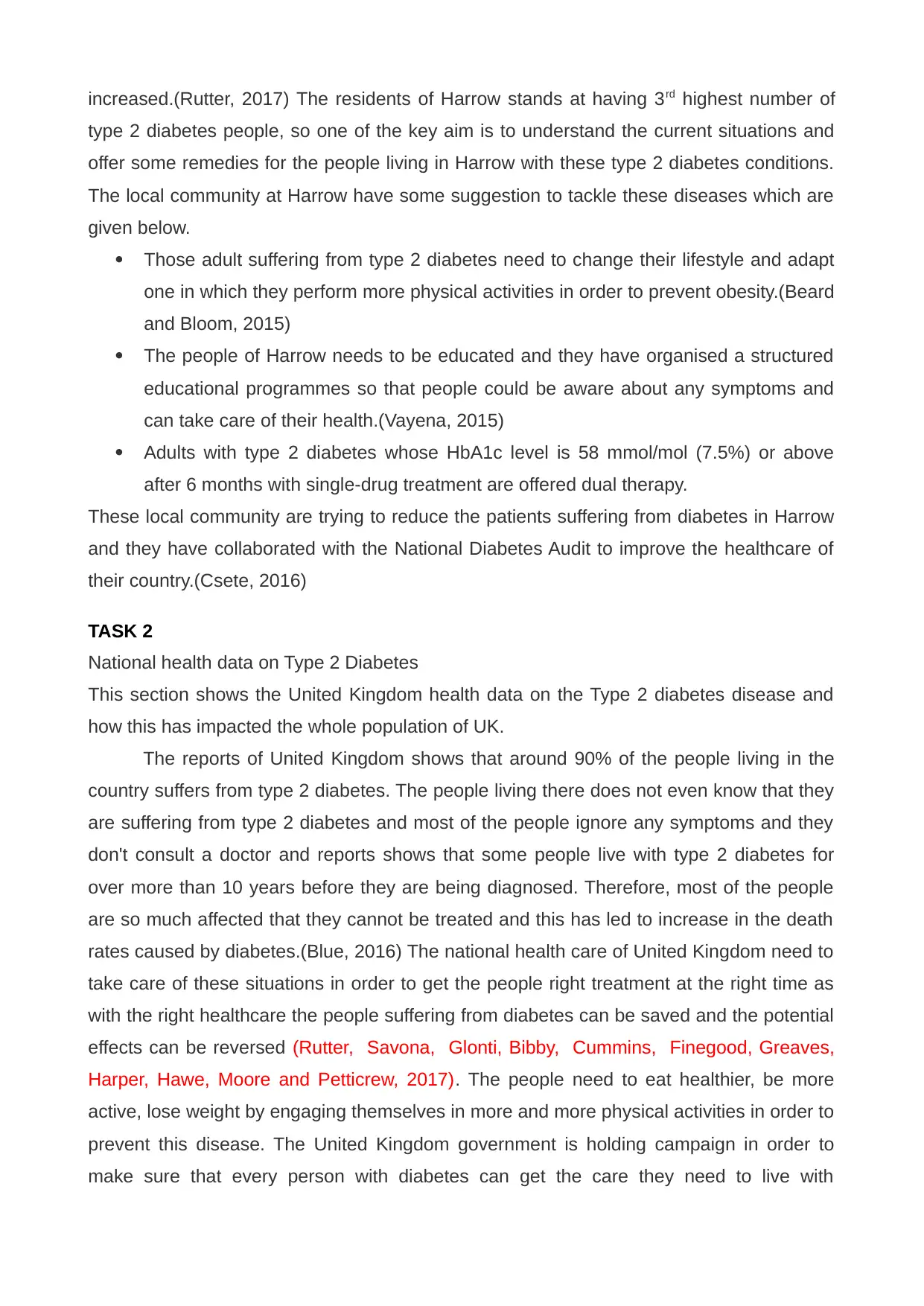
increased.(Rutter, 2017) The residents of Harrow stands at having 3rd highest number of
type 2 diabetes people, so one of the key aim is to understand the current situations and
offer some remedies for the people living in Harrow with these type 2 diabetes conditions.
The local community at Harrow have some suggestion to tackle these diseases which are
given below.
Those adult suffering from type 2 diabetes need to change their lifestyle and adapt
one in which they perform more physical activities in order to prevent obesity.(Beard
and Bloom, 2015)
The people of Harrow needs to be educated and they have organised a structured
educational programmes so that people could be aware about any symptoms and
can take care of their health.(Vayena, 2015)
Adults with type 2 diabetes whose HbA1c level is 58 mmol/mol (7.5%) or above
after 6 months with single-drug treatment are offered dual therapy.
These local community are trying to reduce the patients suffering from diabetes in Harrow
and they have collaborated with the National Diabetes Audit to improve the healthcare of
their country.(Csete, 2016)
TASK 2
National health data on Type 2 Diabetes
This section shows the United Kingdom health data on the Type 2 diabetes disease and
how this has impacted the whole population of UK.
The reports of United Kingdom shows that around 90% of the people living in the
country suffers from type 2 diabetes. The people living there does not even know that they
are suffering from type 2 diabetes and most of the people ignore any symptoms and they
don't consult a doctor and reports shows that some people live with type 2 diabetes for
over more than 10 years before they are being diagnosed. Therefore, most of the people
are so much affected that they cannot be treated and this has led to increase in the death
rates caused by diabetes.(Blue, 2016) The national health care of United Kingdom need to
take care of these situations in order to get the people right treatment at the right time as
with the right healthcare the people suffering from diabetes can be saved and the potential
effects can be reversed (Rutter, Savona, Glonti, Bibby, Cummins, Finegood, Greaves,
Harper, Hawe, Moore and Petticrew, 2017). The people need to eat healthier, be more
active, lose weight by engaging themselves in more and more physical activities in order to
prevent this disease. The United Kingdom government is holding campaign in order to
make sure that every person with diabetes can get the care they need to live with
type 2 diabetes people, so one of the key aim is to understand the current situations and
offer some remedies for the people living in Harrow with these type 2 diabetes conditions.
The local community at Harrow have some suggestion to tackle these diseases which are
given below.
Those adult suffering from type 2 diabetes need to change their lifestyle and adapt
one in which they perform more physical activities in order to prevent obesity.(Beard
and Bloom, 2015)
The people of Harrow needs to be educated and they have organised a structured
educational programmes so that people could be aware about any symptoms and
can take care of their health.(Vayena, 2015)
Adults with type 2 diabetes whose HbA1c level is 58 mmol/mol (7.5%) or above
after 6 months with single-drug treatment are offered dual therapy.
These local community are trying to reduce the patients suffering from diabetes in Harrow
and they have collaborated with the National Diabetes Audit to improve the healthcare of
their country.(Csete, 2016)
TASK 2
National health data on Type 2 Diabetes
This section shows the United Kingdom health data on the Type 2 diabetes disease and
how this has impacted the whole population of UK.
The reports of United Kingdom shows that around 90% of the people living in the
country suffers from type 2 diabetes. The people living there does not even know that they
are suffering from type 2 diabetes and most of the people ignore any symptoms and they
don't consult a doctor and reports shows that some people live with type 2 diabetes for
over more than 10 years before they are being diagnosed. Therefore, most of the people
are so much affected that they cannot be treated and this has led to increase in the death
rates caused by diabetes.(Blue, 2016) The national health care of United Kingdom need to
take care of these situations in order to get the people right treatment at the right time as
with the right healthcare the people suffering from diabetes can be saved and the potential
effects can be reversed (Rutter, Savona, Glonti, Bibby, Cummins, Finegood, Greaves,
Harper, Hawe, Moore and Petticrew, 2017). The people need to eat healthier, be more
active, lose weight by engaging themselves in more and more physical activities in order to
prevent this disease. The United Kingdom government is holding campaign in order to
make sure that every person with diabetes can get the care they need to live with
Paraphrase This Document
Need a fresh take? Get an instant paraphrase of this document with our AI Paraphraser
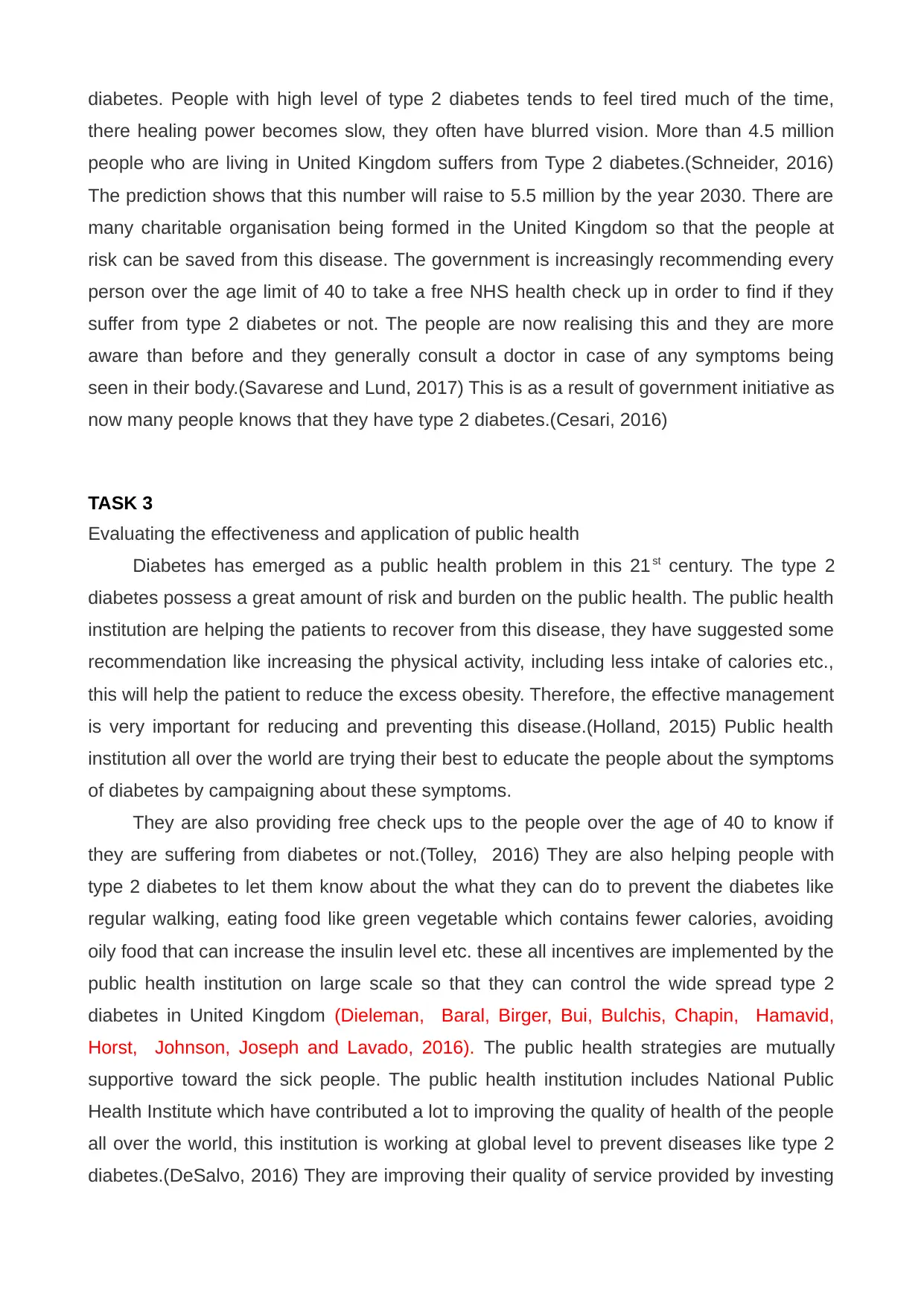
diabetes. People with high level of type 2 diabetes tends to feel tired much of the time,
there healing power becomes slow, they often have blurred vision. More than 4.5 million
people who are living in United Kingdom suffers from Type 2 diabetes.(Schneider, 2016)
The prediction shows that this number will raise to 5.5 million by the year 2030. There are
many charitable organisation being formed in the United Kingdom so that the people at
risk can be saved from this disease. The government is increasingly recommending every
person over the age limit of 40 to take a free NHS health check up in order to find if they
suffer from type 2 diabetes or not. The people are now realising this and they are more
aware than before and they generally consult a doctor in case of any symptoms being
seen in their body.(Savarese and Lund, 2017) This is as a result of government initiative as
now many people knows that they have type 2 diabetes.(Cesari, 2016)
TASK 3
Evaluating the effectiveness and application of public health
Diabetes has emerged as a public health problem in this 21st century. The type 2
diabetes possess a great amount of risk and burden on the public health. The public health
institution are helping the patients to recover from this disease, they have suggested some
recommendation like increasing the physical activity, including less intake of calories etc.,
this will help the patient to reduce the excess obesity. Therefore, the effective management
is very important for reducing and preventing this disease.(Holland, 2015) Public health
institution all over the world are trying their best to educate the people about the symptoms
of diabetes by campaigning about these symptoms.
They are also providing free check ups to the people over the age of 40 to know if
they are suffering from diabetes or not.(Tolley, 2016) They are also helping people with
type 2 diabetes to let them know about the what they can do to prevent the diabetes like
regular walking, eating food like green vegetable which contains fewer calories, avoiding
oily food that can increase the insulin level etc. these all incentives are implemented by the
public health institution on large scale so that they can control the wide spread type 2
diabetes in United Kingdom (Dieleman, Baral, Birger, Bui, Bulchis, Chapin, Hamavid,
Horst, Johnson, Joseph and Lavado, 2016). The public health strategies are mutually
supportive toward the sick people. The public health institution includes National Public
Health Institute which have contributed a lot to improving the quality of health of the people
all over the world, this institution is working at global level to prevent diseases like type 2
diabetes.(DeSalvo, 2016) They are improving their quality of service provided by investing
there healing power becomes slow, they often have blurred vision. More than 4.5 million
people who are living in United Kingdom suffers from Type 2 diabetes.(Schneider, 2016)
The prediction shows that this number will raise to 5.5 million by the year 2030. There are
many charitable organisation being formed in the United Kingdom so that the people at
risk can be saved from this disease. The government is increasingly recommending every
person over the age limit of 40 to take a free NHS health check up in order to find if they
suffer from type 2 diabetes or not. The people are now realising this and they are more
aware than before and they generally consult a doctor in case of any symptoms being
seen in their body.(Savarese and Lund, 2017) This is as a result of government initiative as
now many people knows that they have type 2 diabetes.(Cesari, 2016)
TASK 3
Evaluating the effectiveness and application of public health
Diabetes has emerged as a public health problem in this 21st century. The type 2
diabetes possess a great amount of risk and burden on the public health. The public health
institution are helping the patients to recover from this disease, they have suggested some
recommendation like increasing the physical activity, including less intake of calories etc.,
this will help the patient to reduce the excess obesity. Therefore, the effective management
is very important for reducing and preventing this disease.(Holland, 2015) Public health
institution all over the world are trying their best to educate the people about the symptoms
of diabetes by campaigning about these symptoms.
They are also providing free check ups to the people over the age of 40 to know if
they are suffering from diabetes or not.(Tolley, 2016) They are also helping people with
type 2 diabetes to let them know about the what they can do to prevent the diabetes like
regular walking, eating food like green vegetable which contains fewer calories, avoiding
oily food that can increase the insulin level etc. these all incentives are implemented by the
public health institution on large scale so that they can control the wide spread type 2
diabetes in United Kingdom (Dieleman, Baral, Birger, Bui, Bulchis, Chapin, Hamavid,
Horst, Johnson, Joseph and Lavado, 2016). The public health strategies are mutually
supportive toward the sick people. The public health institution includes National Public
Health Institute which have contributed a lot to improving the quality of health of the people
all over the world, this institution is working at global level to prevent diseases like type 2
diabetes.(DeSalvo, 2016) They are improving their quality of service provided by investing
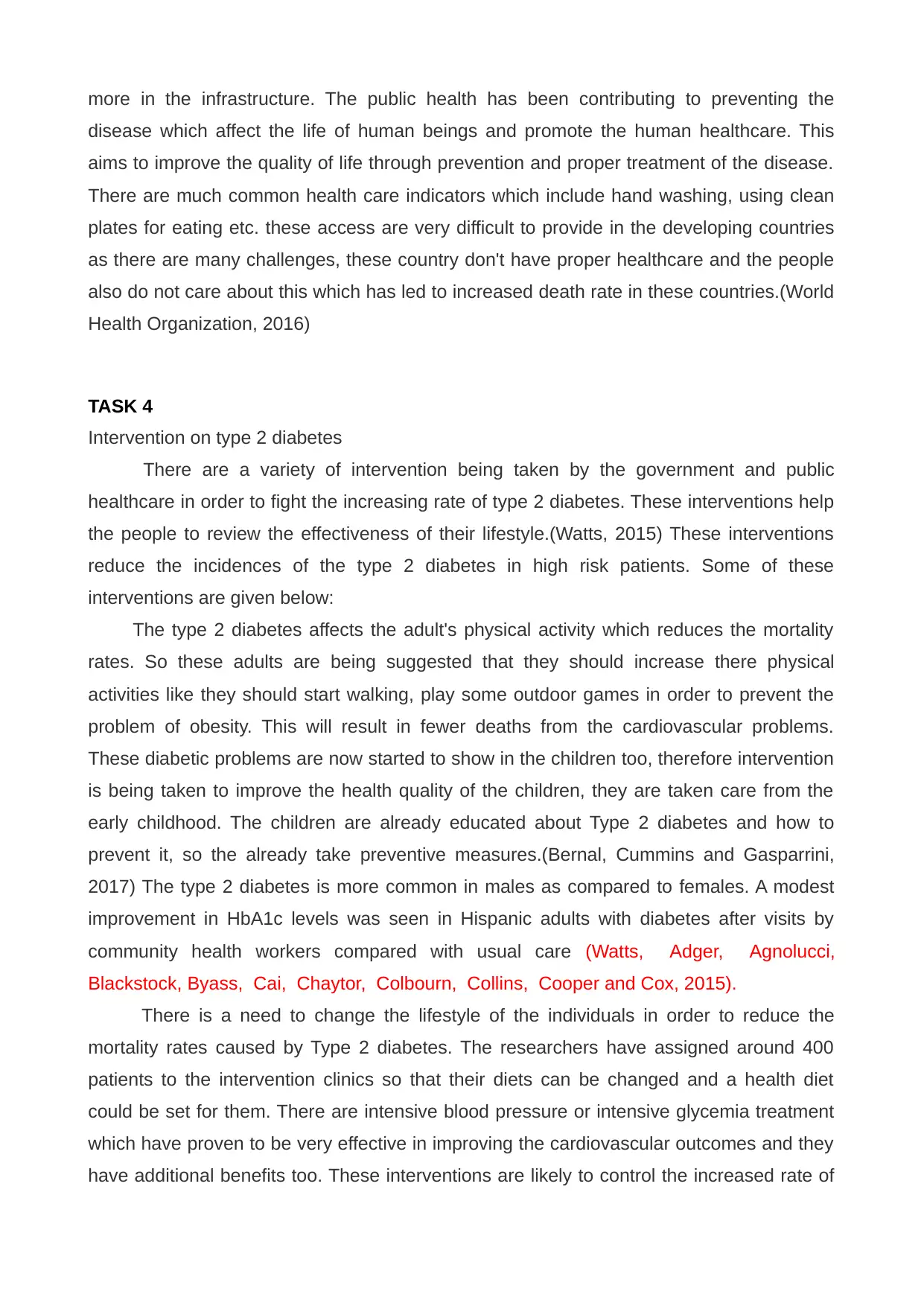
more in the infrastructure. The public health has been contributing to preventing the
disease which affect the life of human beings and promote the human healthcare. This
aims to improve the quality of life through prevention and proper treatment of the disease.
There are much common health care indicators which include hand washing, using clean
plates for eating etc. these access are very difficult to provide in the developing countries
as there are many challenges, these country don't have proper healthcare and the people
also do not care about this which has led to increased death rate in these countries.(World
Health Organization, 2016)
TASK 4
Intervention on type 2 diabetes
There are a variety of intervention being taken by the government and public
healthcare in order to fight the increasing rate of type 2 diabetes. These interventions help
the people to review the effectiveness of their lifestyle.(Watts, 2015) These interventions
reduce the incidences of the type 2 diabetes in high risk patients. Some of these
interventions are given below:
The type 2 diabetes affects the adult's physical activity which reduces the mortality
rates. So these adults are being suggested that they should increase there physical
activities like they should start walking, play some outdoor games in order to prevent the
problem of obesity. This will result in fewer deaths from the cardiovascular problems.
These diabetic problems are now started to show in the children too, therefore intervention
is being taken to improve the health quality of the children, they are taken care from the
early childhood. The children are already educated about Type 2 diabetes and how to
prevent it, so the already take preventive measures.(Bernal, Cummins and Gasparrini,
2017) The type 2 diabetes is more common in males as compared to females. A modest
improvement in HbA1c levels was seen in Hispanic adults with diabetes after visits by
community health workers compared with usual care (Watts, Adger, Agnolucci,
Blackstock, Byass, Cai, Chaytor, Colbourn, Collins, Cooper and Cox, 2015).
There is a need to change the lifestyle of the individuals in order to reduce the
mortality rates caused by Type 2 diabetes. The researchers have assigned around 400
patients to the intervention clinics so that their diets can be changed and a health diet
could be set for them. There are intensive blood pressure or intensive glycemia treatment
which have proven to be very effective in improving the cardiovascular outcomes and they
have additional benefits too. These interventions are likely to control the increased rate of
disease which affect the life of human beings and promote the human healthcare. This
aims to improve the quality of life through prevention and proper treatment of the disease.
There are much common health care indicators which include hand washing, using clean
plates for eating etc. these access are very difficult to provide in the developing countries
as there are many challenges, these country don't have proper healthcare and the people
also do not care about this which has led to increased death rate in these countries.(World
Health Organization, 2016)
TASK 4
Intervention on type 2 diabetes
There are a variety of intervention being taken by the government and public
healthcare in order to fight the increasing rate of type 2 diabetes. These interventions help
the people to review the effectiveness of their lifestyle.(Watts, 2015) These interventions
reduce the incidences of the type 2 diabetes in high risk patients. Some of these
interventions are given below:
The type 2 diabetes affects the adult's physical activity which reduces the mortality
rates. So these adults are being suggested that they should increase there physical
activities like they should start walking, play some outdoor games in order to prevent the
problem of obesity. This will result in fewer deaths from the cardiovascular problems.
These diabetic problems are now started to show in the children too, therefore intervention
is being taken to improve the health quality of the children, they are taken care from the
early childhood. The children are already educated about Type 2 diabetes and how to
prevent it, so the already take preventive measures.(Bernal, Cummins and Gasparrini,
2017) The type 2 diabetes is more common in males as compared to females. A modest
improvement in HbA1c levels was seen in Hispanic adults with diabetes after visits by
community health workers compared with usual care (Watts, Adger, Agnolucci,
Blackstock, Byass, Cai, Chaytor, Colbourn, Collins, Cooper and Cox, 2015).
There is a need to change the lifestyle of the individuals in order to reduce the
mortality rates caused by Type 2 diabetes. The researchers have assigned around 400
patients to the intervention clinics so that their diets can be changed and a health diet
could be set for them. There are intensive blood pressure or intensive glycemia treatment
which have proven to be very effective in improving the cardiovascular outcomes and they
have additional benefits too. These interventions are likely to control the increased rate of
⊘ This is a preview!⊘
Do you want full access?
Subscribe today to unlock all pages.

Trusted by 1+ million students worldwide
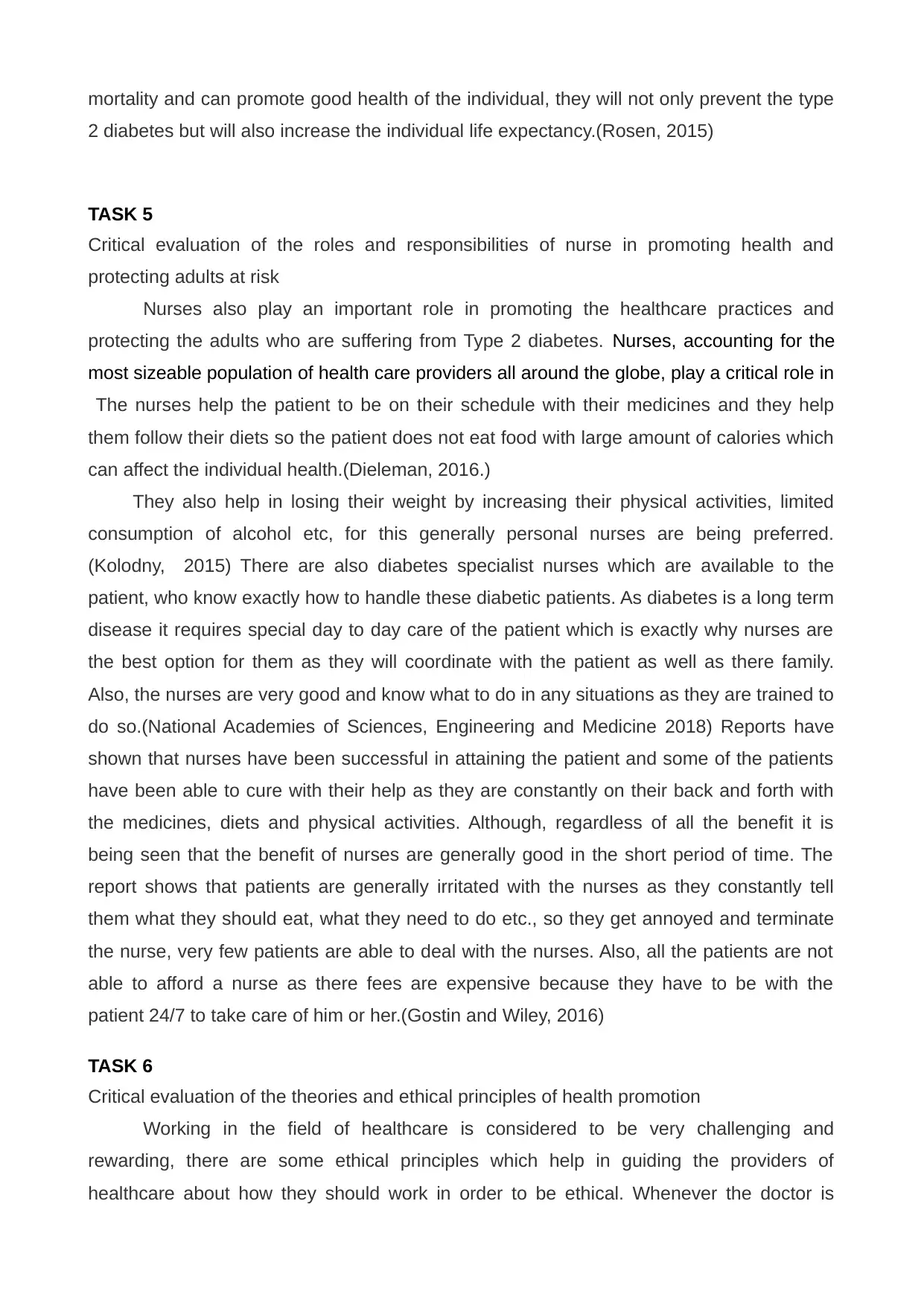
mortality and can promote good health of the individual, they will not only prevent the type
2 diabetes but will also increase the individual life expectancy.(Rosen, 2015)
TASK 5
Critical evaluation of the roles and responsibilities of nurse in promoting health and
protecting adults at risk
Nurses also play an important role in promoting the healthcare practices and
protecting the adults who are suffering from Type 2 diabetes. Nurses, accounting for the
most sizeable population of health care providers all around the globe, play a critical role in
The nurses help the patient to be on their schedule with their medicines and they help
them follow their diets so the patient does not eat food with large amount of calories which
can affect the individual health.(Dieleman, 2016.)
They also help in losing their weight by increasing their physical activities, limited
consumption of alcohol etc, for this generally personal nurses are being preferred.
(Kolodny, 2015) There are also diabetes specialist nurses which are available to the
patient, who know exactly how to handle these diabetic patients. As diabetes is a long term
disease it requires special day to day care of the patient which is exactly why nurses are
the best option for them as they will coordinate with the patient as well as there family.
Also, the nurses are very good and know what to do in any situations as they are trained to
do so.(National Academies of Sciences, Engineering and Medicine 2018) Reports have
shown that nurses have been successful in attaining the patient and some of the patients
have been able to cure with their help as they are constantly on their back and forth with
the medicines, diets and physical activities. Although, regardless of all the benefit it is
being seen that the benefit of nurses are generally good in the short period of time. The
report shows that patients are generally irritated with the nurses as they constantly tell
them what they should eat, what they need to do etc., so they get annoyed and terminate
the nurse, very few patients are able to deal with the nurses. Also, all the patients are not
able to afford a nurse as there fees are expensive because they have to be with the
patient 24/7 to take care of him or her.(Gostin and Wiley, 2016)
TASK 6
Critical evaluation of the theories and ethical principles of health promotion
Working in the field of healthcare is considered to be very challenging and
rewarding, there are some ethical principles which help in guiding the providers of
healthcare about how they should work in order to be ethical. Whenever the doctor is
2 diabetes but will also increase the individual life expectancy.(Rosen, 2015)
TASK 5
Critical evaluation of the roles and responsibilities of nurse in promoting health and
protecting adults at risk
Nurses also play an important role in promoting the healthcare practices and
protecting the adults who are suffering from Type 2 diabetes. Nurses, accounting for the
most sizeable population of health care providers all around the globe, play a critical role in
The nurses help the patient to be on their schedule with their medicines and they help
them follow their diets so the patient does not eat food with large amount of calories which
can affect the individual health.(Dieleman, 2016.)
They also help in losing their weight by increasing their physical activities, limited
consumption of alcohol etc, for this generally personal nurses are being preferred.
(Kolodny, 2015) There are also diabetes specialist nurses which are available to the
patient, who know exactly how to handle these diabetic patients. As diabetes is a long term
disease it requires special day to day care of the patient which is exactly why nurses are
the best option for them as they will coordinate with the patient as well as there family.
Also, the nurses are very good and know what to do in any situations as they are trained to
do so.(National Academies of Sciences, Engineering and Medicine 2018) Reports have
shown that nurses have been successful in attaining the patient and some of the patients
have been able to cure with their help as they are constantly on their back and forth with
the medicines, diets and physical activities. Although, regardless of all the benefit it is
being seen that the benefit of nurses are generally good in the short period of time. The
report shows that patients are generally irritated with the nurses as they constantly tell
them what they should eat, what they need to do etc., so they get annoyed and terminate
the nurse, very few patients are able to deal with the nurses. Also, all the patients are not
able to afford a nurse as there fees are expensive because they have to be with the
patient 24/7 to take care of him or her.(Gostin and Wiley, 2016)
TASK 6
Critical evaluation of the theories and ethical principles of health promotion
Working in the field of healthcare is considered to be very challenging and
rewarding, there are some ethical principles which help in guiding the providers of
healthcare about how they should work in order to be ethical. Whenever the doctor is
Paraphrase This Document
Need a fresh take? Get an instant paraphrase of this document with our AI Paraphraser
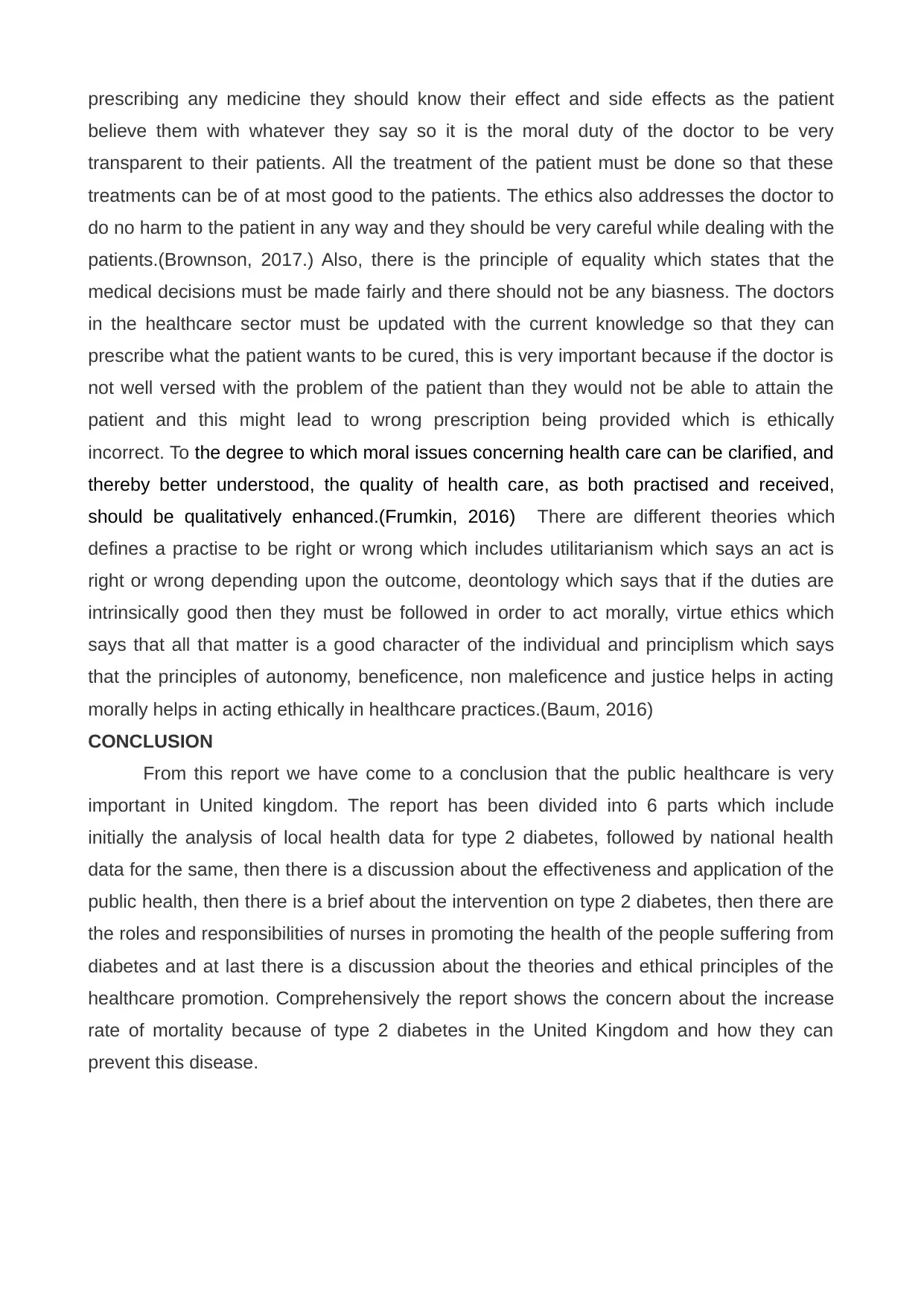
prescribing any medicine they should know their effect and side effects as the patient
believe them with whatever they say so it is the moral duty of the doctor to be very
transparent to their patients. All the treatment of the patient must be done so that these
treatments can be of at most good to the patients. The ethics also addresses the doctor to
do no harm to the patient in any way and they should be very careful while dealing with the
patients.(Brownson, 2017.) Also, there is the principle of equality which states that the
medical decisions must be made fairly and there should not be any biasness. The doctors
in the healthcare sector must be updated with the current knowledge so that they can
prescribe what the patient wants to be cured, this is very important because if the doctor is
not well versed with the problem of the patient than they would not be able to attain the
patient and this might lead to wrong prescription being provided which is ethically
incorrect. To the degree to which moral issues concerning health care can be clarified, and
thereby better understood, the quality of health care, as both practised and received,
should be qualitatively enhanced.(Frumkin, 2016) There are different theories which
defines a practise to be right or wrong which includes utilitarianism which says an act is
right or wrong depending upon the outcome, deontology which says that if the duties are
intrinsically good then they must be followed in order to act morally, virtue ethics which
says that all that matter is a good character of the individual and principlism which says
that the principles of autonomy, beneficence, non maleficence and justice helps in acting
morally helps in acting ethically in healthcare practices.(Baum, 2016)
CONCLUSION
From this report we have come to a conclusion that the public healthcare is very
important in United kingdom. The report has been divided into 6 parts which include
initially the analysis of local health data for type 2 diabetes, followed by national health
data for the same, then there is a discussion about the effectiveness and application of the
public health, then there is a brief about the intervention on type 2 diabetes, then there are
the roles and responsibilities of nurses in promoting the health of the people suffering from
diabetes and at last there is a discussion about the theories and ethical principles of the
healthcare promotion. Comprehensively the report shows the concern about the increase
rate of mortality because of type 2 diabetes in the United Kingdom and how they can
prevent this disease.
believe them with whatever they say so it is the moral duty of the doctor to be very
transparent to their patients. All the treatment of the patient must be done so that these
treatments can be of at most good to the patients. The ethics also addresses the doctor to
do no harm to the patient in any way and they should be very careful while dealing with the
patients.(Brownson, 2017.) Also, there is the principle of equality which states that the
medical decisions must be made fairly and there should not be any biasness. The doctors
in the healthcare sector must be updated with the current knowledge so that they can
prescribe what the patient wants to be cured, this is very important because if the doctor is
not well versed with the problem of the patient than they would not be able to attain the
patient and this might lead to wrong prescription being provided which is ethically
incorrect. To the degree to which moral issues concerning health care can be clarified, and
thereby better understood, the quality of health care, as both practised and received,
should be qualitatively enhanced.(Frumkin, 2016) There are different theories which
defines a practise to be right or wrong which includes utilitarianism which says an act is
right or wrong depending upon the outcome, deontology which says that if the duties are
intrinsically good then they must be followed in order to act morally, virtue ethics which
says that all that matter is a good character of the individual and principlism which says
that the principles of autonomy, beneficence, non maleficence and justice helps in acting
morally helps in acting ethically in healthcare practices.(Baum, 2016)
CONCLUSION
From this report we have come to a conclusion that the public healthcare is very
important in United kingdom. The report has been divided into 6 parts which include
initially the analysis of local health data for type 2 diabetes, followed by national health
data for the same, then there is a discussion about the effectiveness and application of the
public health, then there is a brief about the intervention on type 2 diabetes, then there are
the roles and responsibilities of nurses in promoting the health of the people suffering from
diabetes and at last there is a discussion about the theories and ethical principles of the
healthcare promotion. Comprehensively the report shows the concern about the increase
rate of mortality because of type 2 diabetes in the United Kingdom and how they can
prevent this disease.
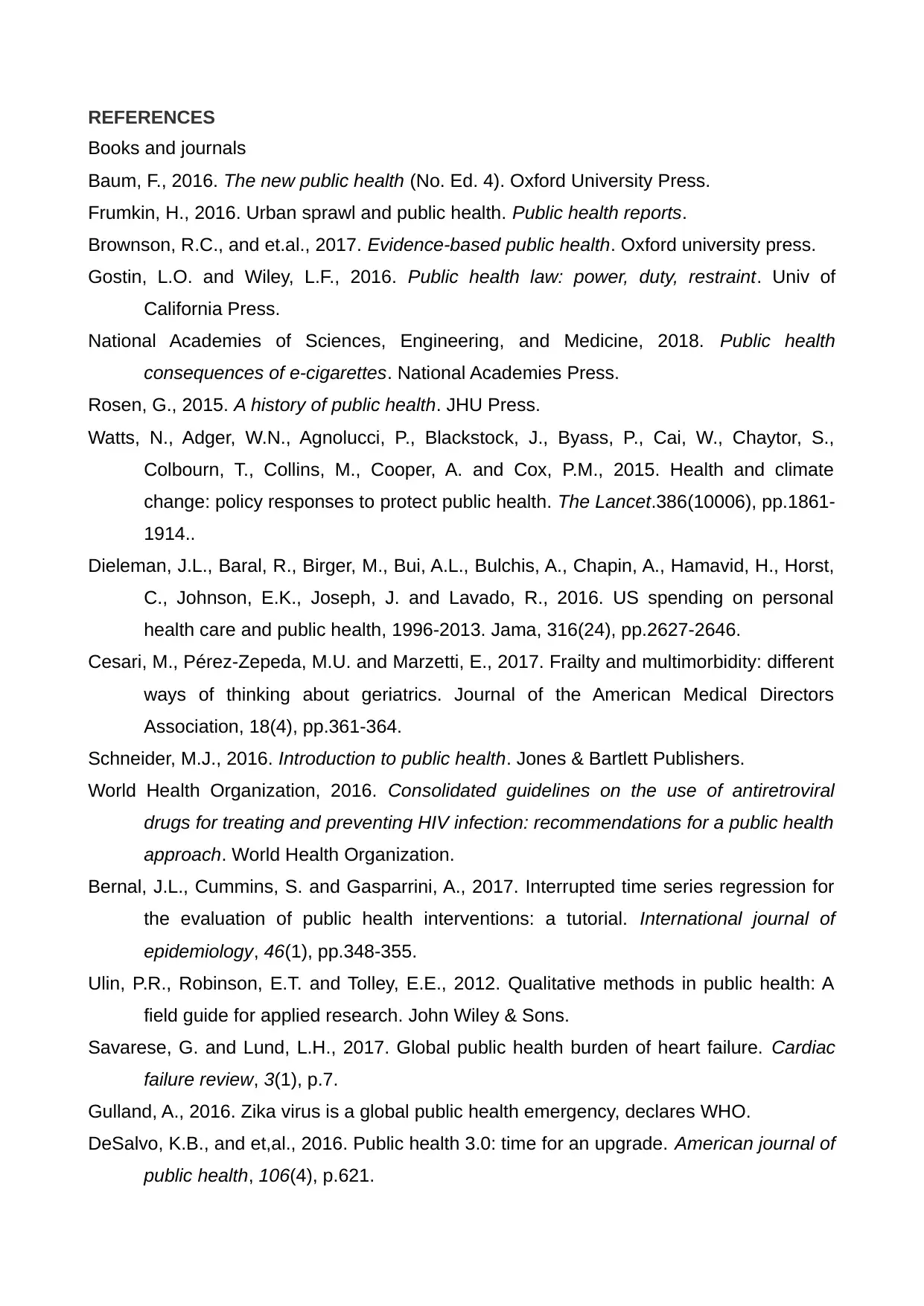
REFERENCES
Books and journals
Baum, F., 2016. The new public health (No. Ed. 4). Oxford University Press.
Frumkin, H., 2016. Urban sprawl and public health. Public health reports.
Brownson, R.C., and et.al., 2017. Evidence-based public health. Oxford university press.
Gostin, L.O. and Wiley, L.F., 2016. Public health law: power, duty, restraint. Univ of
California Press.
National Academies of Sciences, Engineering, and Medicine, 2018. Public health
consequences of e-cigarettes. National Academies Press.
Rosen, G., 2015. A history of public health. JHU Press.
Watts, N., Adger, W.N., Agnolucci, P., Blackstock, J., Byass, P., Cai, W., Chaytor, S.,
Colbourn, T., Collins, M., Cooper, A. and Cox, P.M., 2015. Health and climate
change: policy responses to protect public health. The Lancet.386(10006), pp.1861-
1914..
Dieleman, J.L., Baral, R., Birger, M., Bui, A.L., Bulchis, A., Chapin, A., Hamavid, H., Horst,
C., Johnson, E.K., Joseph, J. and Lavado, R., 2016. US spending on personal
health care and public health, 1996-2013. Jama, 316(24), pp.2627-2646.
Cesari, M., Pérez-Zepeda, M.U. and Marzetti, E., 2017. Frailty and multimorbidity: different
ways of thinking about geriatrics. Journal of the American Medical Directors
Association, 18(4), pp.361-364.
Schneider, M.J., 2016. Introduction to public health. Jones & Bartlett Publishers.
World Health Organization, 2016. Consolidated guidelines on the use of antiretroviral
drugs for treating and preventing HIV infection: recommendations for a public health
approach. World Health Organization.
Bernal, J.L., Cummins, S. and Gasparrini, A., 2017. Interrupted time series regression for
the evaluation of public health interventions: a tutorial. International journal of
epidemiology, 46(1), pp.348-355.
Ulin, P.R., Robinson, E.T. and Tolley, E.E., 2012. Qualitative methods in public health: A
field guide for applied research. John Wiley & Sons.
Savarese, G. and Lund, L.H., 2017. Global public health burden of heart failure. Cardiac
failure review, 3(1), p.7.
Gulland, A., 2016. Zika virus is a global public health emergency, declares WHO.
DeSalvo, K.B., and et,al., 2016. Public health 3.0: time for an upgrade. American journal of
public health, 106(4), p.621.
Books and journals
Baum, F., 2016. The new public health (No. Ed. 4). Oxford University Press.
Frumkin, H., 2016. Urban sprawl and public health. Public health reports.
Brownson, R.C., and et.al., 2017. Evidence-based public health. Oxford university press.
Gostin, L.O. and Wiley, L.F., 2016. Public health law: power, duty, restraint. Univ of
California Press.
National Academies of Sciences, Engineering, and Medicine, 2018. Public health
consequences of e-cigarettes. National Academies Press.
Rosen, G., 2015. A history of public health. JHU Press.
Watts, N., Adger, W.N., Agnolucci, P., Blackstock, J., Byass, P., Cai, W., Chaytor, S.,
Colbourn, T., Collins, M., Cooper, A. and Cox, P.M., 2015. Health and climate
change: policy responses to protect public health. The Lancet.386(10006), pp.1861-
1914..
Dieleman, J.L., Baral, R., Birger, M., Bui, A.L., Bulchis, A., Chapin, A., Hamavid, H., Horst,
C., Johnson, E.K., Joseph, J. and Lavado, R., 2016. US spending on personal
health care and public health, 1996-2013. Jama, 316(24), pp.2627-2646.
Cesari, M., Pérez-Zepeda, M.U. and Marzetti, E., 2017. Frailty and multimorbidity: different
ways of thinking about geriatrics. Journal of the American Medical Directors
Association, 18(4), pp.361-364.
Schneider, M.J., 2016. Introduction to public health. Jones & Bartlett Publishers.
World Health Organization, 2016. Consolidated guidelines on the use of antiretroviral
drugs for treating and preventing HIV infection: recommendations for a public health
approach. World Health Organization.
Bernal, J.L., Cummins, S. and Gasparrini, A., 2017. Interrupted time series regression for
the evaluation of public health interventions: a tutorial. International journal of
epidemiology, 46(1), pp.348-355.
Ulin, P.R., Robinson, E.T. and Tolley, E.E., 2012. Qualitative methods in public health: A
field guide for applied research. John Wiley & Sons.
Savarese, G. and Lund, L.H., 2017. Global public health burden of heart failure. Cardiac
failure review, 3(1), p.7.
Gulland, A., 2016. Zika virus is a global public health emergency, declares WHO.
DeSalvo, K.B., and et,al., 2016. Public health 3.0: time for an upgrade. American journal of
public health, 106(4), p.621.
⊘ This is a preview!⊘
Do you want full access?
Subscribe today to unlock all pages.

Trusted by 1+ million students worldwide
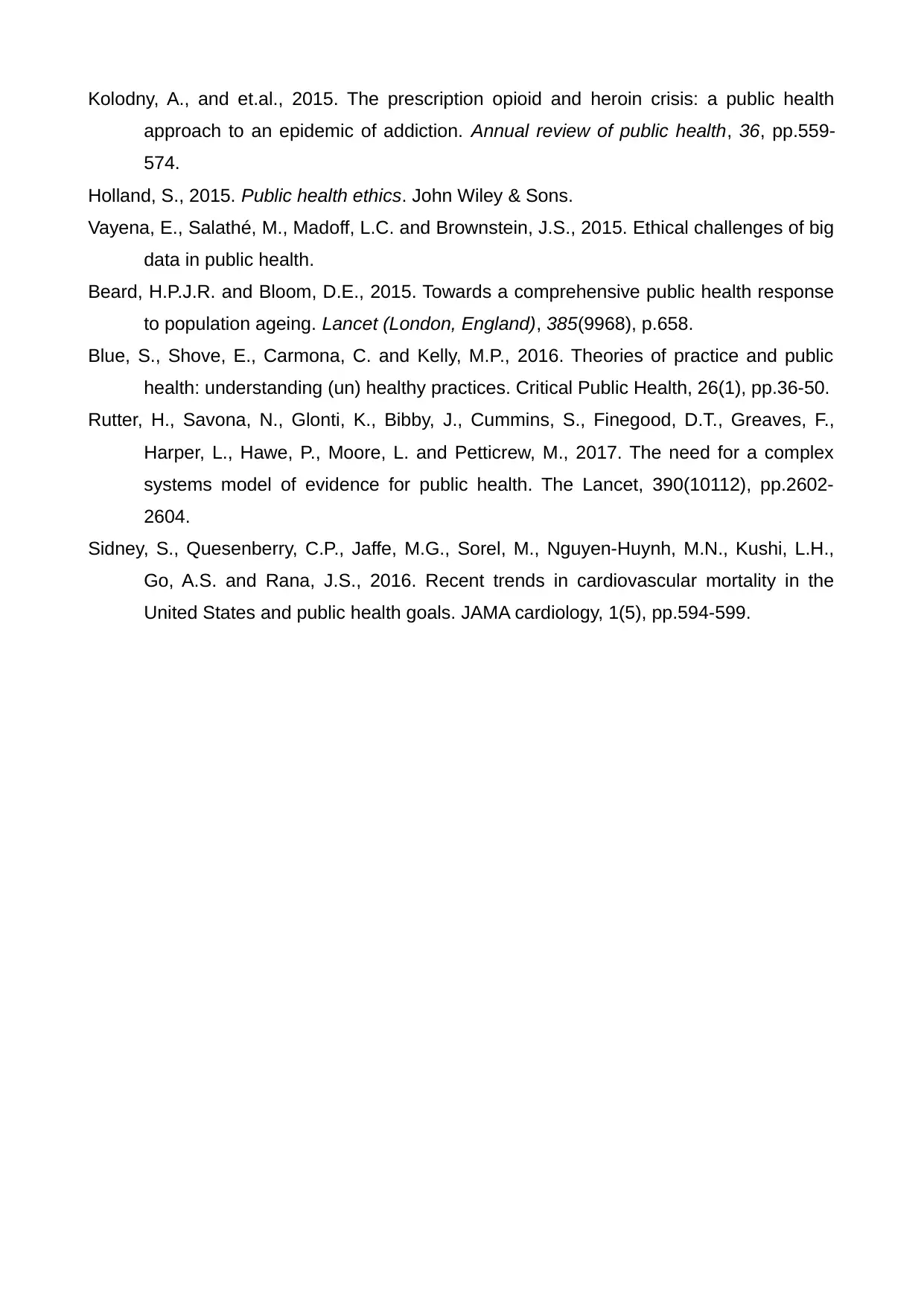
Kolodny, A., and et.al., 2015. The prescription opioid and heroin crisis: a public health
approach to an epidemic of addiction. Annual review of public health, 36, pp.559-
574.
Holland, S., 2015. Public health ethics. John Wiley & Sons.
Vayena, E., Salathé, M., Madoff, L.C. and Brownstein, J.S., 2015. Ethical challenges of big
data in public health.
Beard, H.P.J.R. and Bloom, D.E., 2015. Towards a comprehensive public health response
to population ageing. Lancet (London, England), 385(9968), p.658.
Blue, S., Shove, E., Carmona, C. and Kelly, M.P., 2016. Theories of practice and public
health: understanding (un) healthy practices. Critical Public Health, 26(1), pp.36-50.
Rutter, H., Savona, N., Glonti, K., Bibby, J., Cummins, S., Finegood, D.T., Greaves, F.,
Harper, L., Hawe, P., Moore, L. and Petticrew, M., 2017. The need for a complex
systems model of evidence for public health. The Lancet, 390(10112), pp.2602-
2604.
Sidney, S., Quesenberry, C.P., Jaffe, M.G., Sorel, M., Nguyen-Huynh, M.N., Kushi, L.H.,
Go, A.S. and Rana, J.S., 2016. Recent trends in cardiovascular mortality in the
United States and public health goals. JAMA cardiology, 1(5), pp.594-599.
approach to an epidemic of addiction. Annual review of public health, 36, pp.559-
574.
Holland, S., 2015. Public health ethics. John Wiley & Sons.
Vayena, E., Salathé, M., Madoff, L.C. and Brownstein, J.S., 2015. Ethical challenges of big
data in public health.
Beard, H.P.J.R. and Bloom, D.E., 2015. Towards a comprehensive public health response
to population ageing. Lancet (London, England), 385(9968), p.658.
Blue, S., Shove, E., Carmona, C. and Kelly, M.P., 2016. Theories of practice and public
health: understanding (un) healthy practices. Critical Public Health, 26(1), pp.36-50.
Rutter, H., Savona, N., Glonti, K., Bibby, J., Cummins, S., Finegood, D.T., Greaves, F.,
Harper, L., Hawe, P., Moore, L. and Petticrew, M., 2017. The need for a complex
systems model of evidence for public health. The Lancet, 390(10112), pp.2602-
2604.
Sidney, S., Quesenberry, C.P., Jaffe, M.G., Sorel, M., Nguyen-Huynh, M.N., Kushi, L.H.,
Go, A.S. and Rana, J.S., 2016. Recent trends in cardiovascular mortality in the
United States and public health goals. JAMA cardiology, 1(5), pp.594-599.
1 out of 10
Related Documents
Your All-in-One AI-Powered Toolkit for Academic Success.
+13062052269
info@desklib.com
Available 24*7 on WhatsApp / Email
![[object Object]](/_next/static/media/star-bottom.7253800d.svg)
Unlock your academic potential
Copyright © 2020–2025 A2Z Services. All Rights Reserved. Developed and managed by ZUCOL.




